|
 |
|
|
 |
 |
Antony Tudor and José Limón, and Martha Graham all joined the Julliard faculty in 1951, when the dance division was established, and stayed for several decades. The Masterworks program honors them and also celebrates Tudor and Limón centennials, useful milestones that inspire acquaintance or reacquaintance. Posthumously the choreographers give a solid foundation to the students' Ballet and Modern training. With the hours afforded for rehearsal, and staging by Terese Capucilli, Donald Mahler, Risa Steinberg and Jonathan Riedel, we in the audience are treated to an illuminating evening of dance art. It's a wishful game to foresee the future of dance in this evening. Three works are an object lesson in movement's meaning. Limón, Tudor, and Graham's innovative steps were invented to express psychological and emotional content and departed from tradition to shape the modern era. This was clearly understood by the performing group of Julliard 2nd, 3rd, and 4th year students, who are training in both ballet and modern dance. Being open to new approaches is nothing new for dancers. This crop excelled on Friday and Saturday nights. Graham's 1946 "Appalachian Spring" opened the curtain, with it's folksy Western-style flourishes, and redolent tinges of early settlers' Irish roots. The dance is inexplicably wed to Aaron Copeland's famous music, commissioned for this; he called it "Ballet for Martha." Sustained straight leg extensions with flexed feet and more often pointed feet on the women, lovely turns and jumps with different moods and emphasis, clarify each characterization. Evan Teitelbaum, The Revivalist, does them with severity on Friday. Jamal Callendar's drama and charisma converted the audience on Saturday. The Followers, a chorus of four 'bo-peeps,' especially outdid themselves. Spencer Theberge's earnesty and self-assurance as The Husbandsman impressed in the Friday cast. The Bride character is less assured. Anila Mazhari-Landry delves headlong, playfully swirling in her full, peach, ruffley skirt. Kathryn Wells is the picture of frivolity and gaiety. The couple relives for us the pioneer spirit, and also the redux of post-war hope. Carolyn Rossett and Charlotte Bydewell's (Sat.) Pioneering Womóan is stoic and motherly. The modern ballet "Dark Elegies," the Tudor work without individual characters, portrays a community in grief for some loss, the nature of it's not spelled out in movement. Alaina Williams offers a wonderful meld of ballon and emotion in the beginning. She ends the ballet with a funereal exit of intentionally halting steps. Three women on point lead contingents of bereaved women in plain burgundy, pale blue, and black somber dresses and head wraps. The men wear quiet colors, chinos, white shirts and sweater vests. Nothing flashy here, and as Tudor would have it, their marvelous bravura is never underscored. Yet we relish it beyond the curtain. Solo passages grow increasingly complex and Nathan Madden impresses with introverted turns and high jumps near the final Scene II. Resignation. This 1937 dance is to Gustav Mahler's "Kindertotenlieder," (Songs on the Death of Children.) Its mournful message can hardly be extricated from its time. Baritone Kelly Markgraf sings movingly, seated on stage and dressed like the male dancers. In the balcony Saturday, I heard the proper balance of song and ensemble instruments from AXIOM's able recent Julliard grads. Their wonderful live music, conducted by George Stelluto, was a touch too resounding downstairs in the orchestra. The balcony afforded a view of the exquisite floor patterns in Limón's "There is a Time," in Clifton Taylor's artful lighting. This is the program highlight with twelve overlapping sections that correspond with the Ecclesiastes lines; for example, "A time for embrace, and a time to refrain from embracing;" has Anthony Lomuljo reaching for Sarah Goldstone who dances away. "a time to laugh…a time to dance;" is Chanel DaSilva's joyful spirited solo. In a break from Norman Dello Joio's 1957 Pulitzer prize-winning commissioned score, the dancers create percussion with clapping and thigh slapping. It never quite feels like a natural component of this otherwise fluid performance. Lucie Baker takes us, mourning in a head scarf, or with her hair flying, in the mad "A time to hate, a time of war;" The cast ends like the beginning; a central cluster expands as a ring, hands clasped, in a flower form of light. They dance with rigor and even some passion. The students' young minds and bodies infuse this classic with new, relevant life.
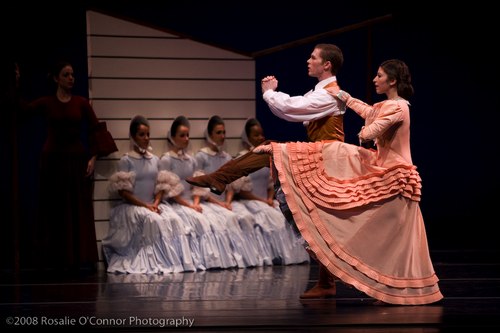 Martha Graham's Appalachian Spring
Bride (peach colored dress) – Anila Mazhari-Landry
Husband – Spencer Theberge
Followers (4 women) – Marla Phelan, Kelly Robotham, Yara Travieso and Allison Ulrich Photo © & courtesy of Rosalie O'Connor |
|
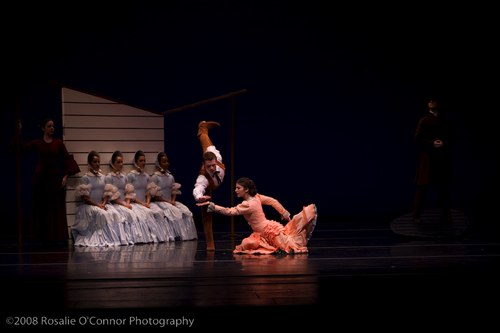 Martha Graham's Appalachian Spring
Bride (peach colored dress) – Anila Mazhari-Landry
Husband – Spencer Theberge
Followers (4 women) – Marla Phelan, Kelly Robotham, Yara Travieso and Allison Ulrich Photo © & courtesy of Rosalie O'Connor |
|
 Martha Graham's Appalachian Spring
Bride (peach colored dress) – Anila Mazhari-Landry
Husband – Spencer Theberge Photo © & courtesy of Rosalie O'Connor |
|
 Martha Graham's Appalachian Spring
Reverend (with long coat) – Evan Teitelbaum
Followers (4 women) – Marla Phelan, Kelly Robotham, Yara Travieso and Allison Ulrich Photo © & courtesy of Rosalie O'Connor |
|
 Martha Graham's Appalachian Spring
Bride (peach colored dress) – Anila Mazhari-Landry
Husband – Spencer Theberge
Pioneering Woman (red dress) – Carolyn Rossett
Followers (4 women) – Marla Phelan, Kelly Robotham, Yara Travieso and Allison Ulrich Photo © & courtesy of Rosalie O'Connor |
|
 Antony Tudor's Dark Elegies
Alaina Williams Photo © & courtesy of Rosalie O'Connor |
|
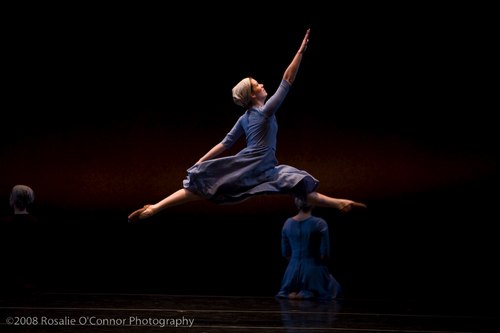 Antony Tudor's Dark Elegies
Alaina Williams Photo © & courtesy of Rosalie O'Connor |
|
 Antony Tudor's Dark Elegies
Alaina Williams Photo © & courtesy of Rosalie O'Connor |
|
 Antony Tudor's Dark Elegies
Erica Furst Photo © & courtesy of Rosalie O'Connor |
|
 José Limón's There is a Time Photo © & courtesy of Rosalie O'Connor |
|
 José Limón's There is a Time
Troy Macklin Photo © & courtesy of Rosalie O'Connor |
|
 José Limón's There is a Time Photo © & courtesy of Rosalie O'Connor |
|
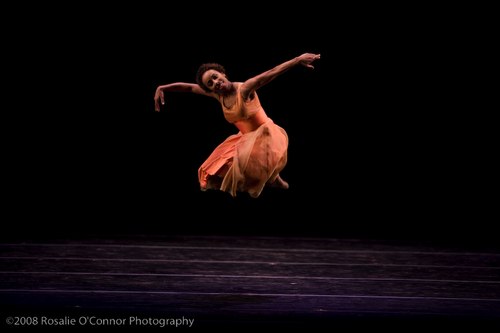 José Limón's There is a Time
Chanel DaSilva Photo © & courtesy of Rosalie O'Connor |
|
 José Limón's There is a Time
Sarah Goldstone and Anthony Lomuljo Photo © & courtesy of Rosalie O'Connor |
|
 José Limón teaching at Juilliard, February 24, 1959. Photo © & courtesy of Impact Photos Inc. |
|
 Martha Graham Photo © & courtesy of Unknown |
|
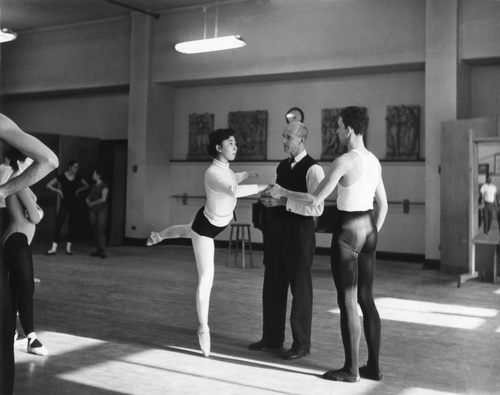 Anthony Tudor (center) with students, male dancer is John Barker, member of Juilliard Dance Theater, 1955-56 Photo © & courtesy of Unknown |
|
|
|


















